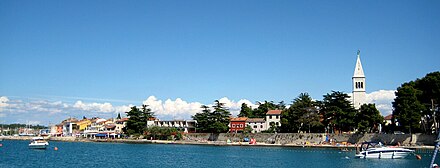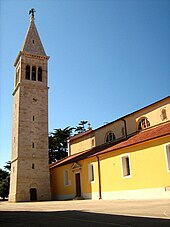Novigrad (Istria)
|
Novigrad Cittanova |
|||
|
|||
|
|
|||
| Basic data | |||
|---|---|---|---|
| State : |
|
||
| County : |
|
||
| Height : | 0 m. i. J. | ||
| Area : | 27 km² | ||
| Residents : | 4,345 (2011) | ||
| Population density : | 161 inhabitants per km² | ||
| Telephone code : | (+385) 052 | ||
| Postal code : | 52466 | ||
| License plate : | PU | ||
| Boat registration : | ND | ||
| Structure and administration (status: 2013, cf. ) |
|||
| Community type : | city | ||
| Mayor : | Anteo Milos (IDS-DDI) | ||
| Postal address : | Veliki trg 1 52466 Novigrad |
||
| Website : | |||
| Others | |||
| Patron saint : | St. Pelagius | ||
Novigrad [ ˈnɔʋiɡraːd ] (Croatian) or Cittanova (Italian; until 1945 Cittanova d'Istria ) is a town in Istria County , Croatia .
It rests on the remains of a settlement Civitas Nova or Emonia from ancient times and was the seat of a diocese from 381 to 1831 .
It is located on the coast about 15 km north of Poreč on a small island that was only connected to the mainland in the 18th century.
Districts
The municipality of Novigrad / Cittanova consists of the following districts (population according to the 2011 census):
- Antenal / Antenal (152)
- Bužinija / Businia (936)
- Dajla / Daila (396)
- Mareda / Mareda (239)
- Novigrad / Cittanova (2,622)
history
Antiquity
The history of the city goes back to ancient times . Even Greek sailors had here a foothold, remaining ruins of the former settlement are flooded by the sea today.
There was probably a Roman villa on the peninsula in late antiquity , around which the Roman settlement Civitas Novum (from which today's Cittanova is derived, which was translated as Novigrad under Yugoslavia) arose.
381 a bishop Maximus from Civitas Nova is mentioned for the first time at the Synod of Aquileia .
After the fall of the Western Roman Empire in 476, the city was assigned to the Byzantine Empire .
Towards the end of the 5th century, the city came under Ostrogothic rule. Submission by the Ostrogoths ended in 538 after the Byzantine victory in the Gothic War .
In the 6th century, refugees from the Roman Emona (today's Ljubljana ) also sought refuge and gave the place the name Emonia . From the middle of the 6th century to around 600 bishops of Emonia are documented.
The city is first mentioned in a document from Pope Gregory the Great in 599 .
From 751 to 774 Novigrad / Cittanova was under the rule of the Longobards .
Frankish Empire and Holy Roman Empire
In 788 the city came under Frankish rule. From 800 to 1831 the bishops of Emonia and Civitas Nova are recorded.
From 976 Cittanova becomes part of the Duchy of Carinthia .
During the 11th and 12th centuries the city was ruled by different patriarchs.
Venetian supremacy
In the 12th century the influence and supremacy of Venice in the Adriatic region around Istria grew stronger. In 1270 Novigrad / Cittanova finally came under the Venetian protective power, which lasted until the fall of the Lion Republic in 1779.
In addition, an earthquake on March 26, 1511 caused major damage.
As part of the Venetian Empire, Cittanova repeatedly got into armed conflicts, for example during the conflict between Venice and the Republic of Genoa or during the Uskok War from 1615 to 1617.
In 1687 Novigrad / Cittanova suffered from looting and kidnapping by warriors of the Ottoman Empire .
In addition to the armed conflicts, the plague and malaria also hit the residents.
In the 16th and 17th centuries the city, which was now called Neapolis , had mostly only a few hundred inhabitants who lived impoverished in dilapidated buildings.
After all, thanks to Venetian investors, a renewed upswing set in at the beginning of the 18th century, the newly constructed buildings of which still shape the cityscape of the historic old town.
Napoleonic period
After the fall of the Republic of Venice (1797) and the establishment of the Kingdom of Italy in 1805, Cittanova, like the entire coast of Istria, came under the influence of Napoleon .
Austrian Empire
At the Congress of Vienna in 1815, when the region of Illyria was assigned to the Habsburgs , Cittanova was also placed under Austrian rule.
In 1828 the diocese of Cittanova was abolished by a papal decree and joined to the diocese of Trieste and Capodistria .
After the First World War and the end of the Austro-Hungarian monarchy, Cittanova, like all of Istria and Trieste, came back to the Kingdom of Italy .
Italy
In the Rapallo border treaty of 1920, the region around Cittanova was added to Italy.
German occupation
Towards the end of World War II , after Italy's surrender, the city fell to Nazi Germany from 1943 to 1945 .
Yugoslavia
After the Second World War, Cittanova was first assigned to Zone B of the Free Territory of Trieste in 1947 . On October 26, 1954, the area of Zone B (with Cittanova) was definitively handed over to the Socialist Federal Republic of Yugoslavia . The name was changed from Cittanova to Novigrad. The city belonged to Yugoslavia's republic of Croatia .
Republic of Croatia
On June 25, 1991 the Republic of Croatia declared its state independence. The Istria region was not directly affected by the turmoil of the Yugoslav wars, but Novigrad / Cittanova, like other tourist coastal towns, housed many refugees in hotels and tourist accommodation.
population
According to the 2011 census, the municipality of Novigrad had 4,345 inhabitants, of whom 2,050 were male and 2,295 were female.
According to ethnicity, 66.4% of the inhabitants of the municipality were Croats , 10.2% Italians , 3.4% Albanians , 2.8% Serbs , 2.1% Slovenes , 0.9% Bosnians , 0.3% Germans and Austrians and 1.2% others. 10.7% of the inhabitants called themselves Istrians or stated another regional affiliation. For the remaining 2.0%, the ethnicity was not given or was unknown. By citizenship, 97.7% were Croatians (of which 10.2% had dual citizenship) and 2.2% were foreigners. The nationality of the remaining 0.1% of the population was unknown.
81.1% used Serbo-Croatian as their mother tongue , with 79.3% describing the language as Croatian , 1.0% as Serbian and 0.5% as Bosnian . 12.5% named Italian as their mother tongue, 3.2% Albanian , 2.3% Slovenian , 0.3% German and 0.5% stated another language. The mother tongue of the remaining 0.1% of the population was unknown. The official languages of the municipality are Croatian and Italian.
According to religion, 80.9% of the population were Catholics , 2.8% Orthodox , 1.9% Muslims , 0.2% Protestants and 0.3% indicated a different religious affiliation. 8.9% were non-denominational , in the remaining 5.0% the religion was not given or was unknown.
Buildings and sights
Parish church of St. Pelagius with steeple
The parish church of St. Pelagius is also dedicated to St. Maxim and St. Mary. The three-aisled basilica was the cathedral of the diocese of Cittanova until 1828.
The beginning of the construction of the church can no longer be determined today, depending on the sources this was from the middle of the 5th to the middle of the 8th century. Different information is also available about the following expansions and modifications. The church was probably expanded in the Gothic style at the end of the 13th century, redesigned several times between the 15th and 18th centuries and partly redesigned in Baroque style . The cathedral originally included a baptistery and a bishop's palace, which were demolished in the 19th century. The current neoclassical facade was completed in 1935.
The interior is dominated by the baroque altar and the raised, deep choir. In the church there is a series of portraits of 30 bishops formerly in office in Novigrad, as well as a larger painting each with a portrait of Our Lady with the two church saints Maximus and Pelagius (artist unknown) and Saints Karl, Lucia and Anton (by Carlo Alvise Fabris from 1776).
Under the choir there is also a three-aisled crypt with cross vaults - the only one of its kind in Istria and one of the few in all of Croatia.
The free-standing bell tower at the church square Veliki trg was built in 1883 based on the model of the Markus Tower in Venice , as a replacement for a tower that was added to the cathedral front until 1874. On the top of the pyramid of the 45-meter-high tower, a wooden statue of St. Pelagius, clad in bronze, has stood since 1913 .
In the small pine forest between the Pelagius Church and the north-western coast there is a simple stone sarcophagus , probably from the 12th century. The coffin lid has the shape of a gable roof and has beautiful decorations on the corners.
City wall / loggia
The mostly crenellated old town wall was built around the 13th century, possibly on the ruins of a late antique fortification. The wall was originally lower; only in the course of time was this raised and the battlements added. The wall once surrounded the entire island of the city. It is still well preserved today and still covers almost the entire peninsula. The masonry is complemented by two round Renaissance towers, the square tower at the former city gate is somewhat older.
Built on an older structure of the defensive walls or even on the ruins of a tower, the loggia , called Belveder , was built around the 16th century with a direct view of the sea . To the west opposite the loggia is the Porta a marina , an arched passage that leads to the sea. This construction, the year 1649 is carved into the stone, was relocated from the northwestern part of the city to its present location more than a hundred years ago when the new city park was built.
Museums
The Lapidarium is a museum with a collection of around 100 stone monuments. The modern glass house is to the west opposite the Pelagius Church .
The private war museum Gallerion by photographer Sergio Gobbo, opened in 2005, is dedicated to the Austro-Hungarian fleet of the Austro-Hungarian Navy during the First World War.
The Rigo City Palace was built in 1770 by the Novigrad noble family Rigo . The palace, which is harmoniously decorated with decorative elements, is an example of the Central European Baroque. The building front was renovated in 1994. Today, the Galeria Rigo for modern and contemporary art, named after the family, is located on the ground floor .
Churches
The Church of Our Lady of Carmel (Chiesa della Vergine Maria del Carmelo or Crkva Gospe od Karmela) was built towards the end of the 15th century in the single-aisle style typical of Istria at the time, and in the second half of the 18th and first half of the 19th century Renewed for the last time in the following century. Formerly there was a small monastery next to the church, which was run by the Dominicans from the 15th to 17th centuries , by the Augustinians from the second half of the 17th century and then by the Franciscans until the middle of the 18th century .
The three-aisled St. Agatha Church stands towards the city exit at the old city cemetery . The church with its striking gable roof was built in the 10th or 11th century in the Romanesque style. Inside the church, which was renovated between 1993 and 1995, there are two late baroque sculptures (depicting angels bringing light) and the altarpiece of Agatha of Catania .
North-east of the old town opposite the marina is the medieval St. Anton church built in the Gothic style . The church was redesigned both in the 17th century and in the middle of the 19th century by enlarging the chancel and breaking out two side windows.
Web links
- Novigrad Official website of the city of Novigrad (Croatian)
- Cittanova Official website of the city of Cittanova (Italian)
- Istrian from Smrikve Description Novigrad / Cittanova (English)
- official website of the Muzej / Museo Lapidarium (German)
- official website of the Gallerion - Adriatic Nautical Collections (German)
- official website of Galerija Rigo (Croatian)







